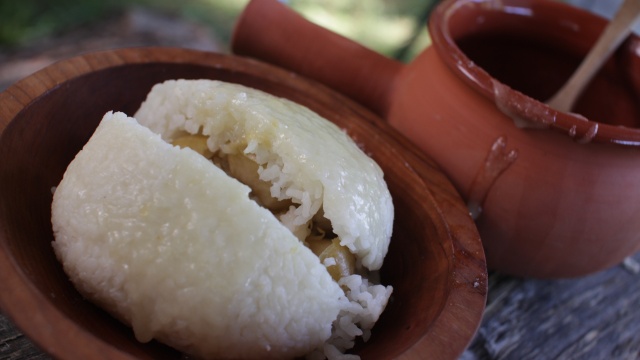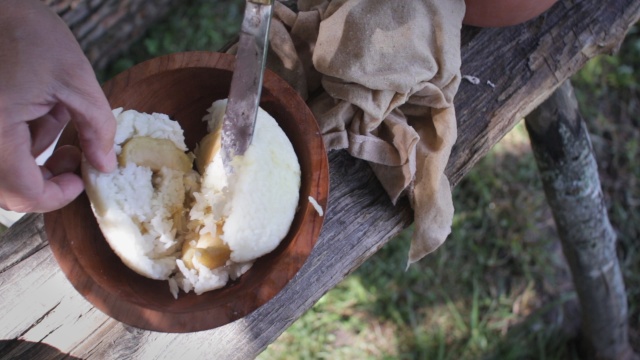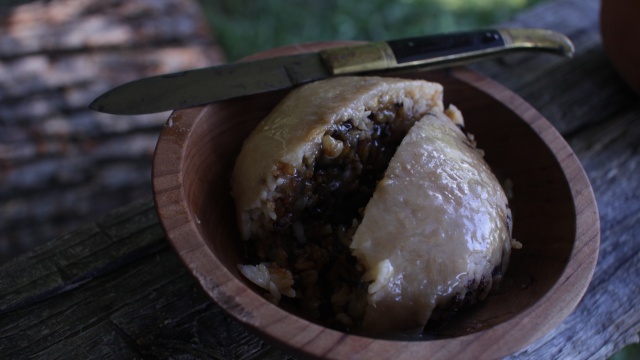As a follow-up to my last post as well as to our latest video, I’m offering a couple of 18th century recipes from the 1767 cookbook, Primitive Cookery; or the Kitchen Garden Display’d. As I previously mentioned, this book was a collection of recipes that were “borrowed” from other sources: the two recipes I’m highlighting were originally from Hannah Glasse’s earlier cookbook The Art of Cookery. Both recipes happen to use rice as their main ingredient.
Rice was an important food in 18th century English diets. That topic, however, is far too complex to be addressed at this time. Entire books have been written on the subject. One that I would highly recommend is Carolina Rice Kitchen: The African Connection by Karen Hess.
I struggled a bit writing this post. Normally, I enthusiastically celebrate 18th century foods. In contrast, this post has brought a certain degree of sobriety.
Much of the rice enjoyed on English tables originated either from West Africa or South Carolina and Georgia. While indigenous rice had been cultivated in Africa for thousands of years, it wasn’t until possibly the 16th century that the finer, whiter oriental varieties were introduced. The crop was so successful there and the grain so popular, that its production quickly surpassed the indigenous varieties.
By the late 1600s, these strains of rice had also been introduced to the swamplands of South Carolina and portions of Georgia. Within a few years, hundreds of tons of rice were being exported. The success of the crop in the colonies was directly due to the expertise of African slaves brought from the rice-growing regions of West Africa.
We cannot correct the inhumanities of history by ignoring them. While the purpose of this post is to examine two very simple rice recipes, I do not want to overlook the reality that lies behind them. The fact is, the luxuries enjoyed by so few were the result of the blood, sweat, and tears of so many.
So are these recipes.
Having said that, here are the recipes. They are exceptionally easy to make.
Carolina rice was a long grain rice. In my experience with these recipes, I found a medium grain rice to work better than a modern extra-long grain rice. The quantities used in these recipes are almost irrelevant. There is a great deal of latitude in terms of how much rice you use. I also found that while you need to leave some room in the pudding cloth for the rice to expand, if you leave too much, the end result will be a bag of soggy rice rather than a well-formed pudding ball.
One other word of advice draws upon 18th century kitchen wisdom that is not mentioned in these recipes: once the puddings are done boiling, you may find it easier to remove them from the pudding bag if you first dip them in cold water for a few seconds.
Finally, this recipe calls for a sauce of equal parts melted butter and sugar. In my opinion, the sauce really makes these dishes. If, however, you choose to not use butter, you may want instead to try drizzling some sherry sweetened with a little sugar.





Thankyou so much for finding these old recipes and bringing them back to life. I will have fun making these rice puddings for my family and friends. Keep up the good work, it looks like you love it. All the best, Karen in New Zealand
Thank you, Karen!
Interesting in that rice and raisins was a big part of my family diet especially when young. It was a desert when little but later became a breakfast food. I would guess since most of my ancestry came from the old South and moved to the midwest in the 19th century, they brought the idea with them. Our version was cook raisins in with the rice and when done add sugar and milk. I love the sensation of the cold milk and warm rice and raisins together. Thanks for the trip down memory lane.
Part of the beauty of this site is the doors that it opens. As a homeschooling family, it is a wonderful way to bring history alive. Our kids are not just reading about their heritage, but actually able to experience the sights, textures, smells and of course the tastes of the past. It makes history that much more real. Thank you for sharing your passion with theret of us!
Beautiful recipes. Tried both with rice grown in South Carolina (something very rare these days) and could not believe my taste buds. A taste so exquisite from so simply a dish. People could take many lessons from the Houses of Olde,
Thanks for posting the original recipes and telling us more about them, even though they have a painful provenance. One question: What kind of cloth did you use for boiling the rice? I’m guessing cheesecloth but maybe I’m wrong.
The weave of cheesecloth is too loose. Any normal cotton or linen fabric will do. Linen was used most often in the 18th century. Muslin works very well.
A couple questions:
Do you think this dish could be made with millet?
Does “raisins stoned” refer to de-seeded raisins? Would they be de-seeded before drying? This is something I’ve long wondered.
Thank you for this recipe! It’s on my list of apple must-makes this week.
A couple question:
Are the ‘raisins stoned’ mentioned above from de-seeded grapes? Were they de-seeded before or after drying? I’ve long wondered this.
Would millet work in place of rice for the Carolina Snowball? Was millet common 18th century America?
Thank you! I’m looking forward to trying this recipe!
While the vast majority of modern raisins are made from seedless grapes, many 18th-century raisins had seeds in them and had to be stoned prior to use. It would have been a very tedious and sticky job for the cook! The period raisin-making methodologies I’ve read are clear that raisins were not stoned prior to drying. Now there were, however, some seedless varieties of raisins at that time; for instance, raisins from the small Corinth grapes were wildly popular. These raisins were call currants — a name that was also applied to the garden currant (akin to the gooseberry). Be sure to read my recent blog post on currants if you would like more information on that: http://www.savoringthepast.net/2014/07/21/currant-challenges/. In the U.S., we tend to make a distinction between the two by calling the berry version “currants” and the raisin version “Zante currants,” but my conclusion thus far is that in the 18th century, the two, though very different, were interchangeable.
As for millet, I have done only a little research on this topic, but I believe it merits more. The few resources I’ve seen seem to suggest it was a grain used more often by poorer segments of society. Apparently, provincial slave cultures also developed around its cultivation in the colonies. I do not know if it would work in this recipe. It would be an interesting experiment.
Thanks for the questions. More research is obviously needed.
I’m back to report on my millet and brown rice snowballs. The brown rice didn’t hold together well but the millet snowball did (the apple bopped the to top, but I served it upside down so it didn’t show). Perhaps I allowed too much room in the bags. The millet was a bit sweeter, maybe it picked up more flavor from the apple. Everyone enjoyed this dish and four out of five preferred the millet. I made a delicious sauce with coconut oil, cinnamon, nutmeg, and extra apple frosting (made with palm oil shortening, powdered sugar and apple cider) from a recent birthday cake. I’d like to try it again with sweet sticky brown rice and one with white rice…okay, and a third one with millet. Yum.
An original recipe full of flavor and easy to prepare! Delicious recommendation.
Pingback: Snowballs: Intermixing Gentility and Frugality in Nineteenth Century Baking | The Recipes Project
Pingback: Peach Snowballs « Turnspit & Table
I have an 18th century edition of The Art of Cookery and this recipe, among many, I was intrigued by. Thank you.